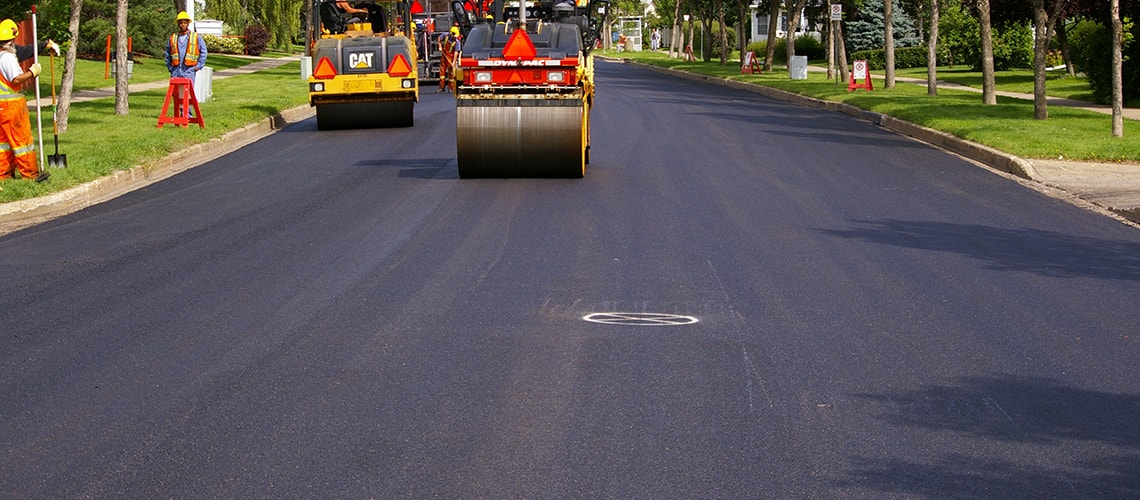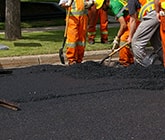Edmonton City Paving – Edmonton, AB
Edmonton City Paving – Edmonton, AB
This project was the culmination of a two year relationship with the City of Edmonton where they have been using EZ Street cold asphalt for maintenance patching applications. EZ Street Canada and Al Cepas from the City of Edmonton had determined a location to try EZ Street asphalt as a paving alternative to their regular paving program.
The work was performed in early August, 2011. The chosen location is in the Lago Lindo suburb in Northern Edmonton. The whole of 168th Avenue NW / 95th Street NW intersection was being paved and the EZ Street asphalt section ran from the 174th Avenue intersection north for 300m, past 176 Avenue NW.
The site is a suburban road and is a designated bus route. The City paving program had a 2km section of the street planned for resurfacing, including a piece to trial the installation of EZ Street cold asphalt. The City paved approximately 1km of asphalt first, then 300m of EZ Street asphalt followed by asphalt to complete the job. The idea was to trial the EZ Street asphalt product for sound reduction and to provide a controlled area for the crews to learn to work with the EZ Street asphalt product. The site was pre-milled and the paving was performed in one, 50mm lift. The City of Edmonton has their own paving crews and utilized their modern paving equipment. They recently acquired a new Vogele paver and standard Cat rollers (both steel drum and PTR). For the EZ Street cold asphalt application, the city involved both of their paving crews as well as a number of management and supervisory staff along to see the paving of our product in action.
This EZ Street asphalt section has proven to be a success in a number of ways for the City. First, they have found a product that can provide a significantly quieter road surface that has applications anywhere there are noise sensitive areas, from general urban environments through to roads outside hospitals, etc. Secondly, the City was very impressed by the single mat surface (no cold joints / paver runs) and thirdly, and most importantly for the City of Edmonton, is that the currently limited paving season can potentially be expanded by around twelve weeks. This alone will be an enormous benefit to the City and can apply to any city or municipality through Canada which has a limited season due to cold winters.
The crews found paving with EZ Street cold asphalt to be easier than paving with regular asphalt. Even though it was the first time the crews had worked with EZ Street asphalt at this scale, they quickly adapted to the different material and found some shortcuts in the placement of the product compared to the hot-mix asphalt.
With no temperature constraints due to the hot asphalt, the roller drivers found they could work away from the paver and get long roller runs in instead of the usual procedure of being behind the paver the moment the asphalt is on the ground.
The end result of the experiment was that:
- The final product outperformed expectations. The surface is holding strong, with even the bus stop area showing no sign of stress or deterioration.
- The crew found EZ Street cold asphalt a lot more forgiving to work with when patching and filling in hollows, etc. They could go back in a timeframe that hot asphalt will not usually allow to patch and fill the low areas with no visual deficiencies or delamination that will occur when patching over cooling asphalt.
- The crews liked that EZ Street asphalt did not stick to any of the hand tools or to the shoes. Also, working with a cold product made the handling of EZ Street asphalt a lot more bearable than working with hot asphalt on a warm day
- The crews noticed and discussed two other benefits of EZ Street cold asphalt that have quite a visual impact on their first application. These were firstly, that the EZ Street asphalt went much further than the regular asphalt (about 10% further) which became evident to the paver crew, as each truck and hopper load was taking them further down the road than they had been used to. Secondly, the single mat / no cold joint became very evident to everyone as the EZ Street asphalt was being paved. As soon as the roller went over the adjoining mats, the seam disappeared. At the end of the job, the paved area showed as a 300m long section with one 10m wide mat. All of the paver joints / cold joints of the conventional asphalt are very evident on this site but they end when they meet the EZ Street asphalt section.
In August 2011, a 300m long section of 95th Street North of 174th Avenue NW was paved with EZ Street Asphalt to provide a comparison between the performances of EZ Street Asphalt to regular asphalt. As discussed in the installation case study , regular asphalt was used to pave 1km of road, then a 300m long section of EZ Street Asphalt was installed to complete the job. This enabled us to directly compare the results on the first year of wear and tear (including an Edmonton winter) on the two pavement surfaces.
Visual inspections and comparisons have been performed on the two sections with the following observations:



Overall Performance:
Both the conventional City of Edmonton ACO mix with 150-200A asphalt binder and the EZ Street Asphalt mix have performed well over the winter.
Macro-Texture:
The better macro-texture, the better skid resistance characteristics. The surface texture of the EZ Street Asphalt is very consistent and has a greater macro-texture than the regular asphalt.
Segregation | Surface Deterioration:
The regular asphalt surface shows some signs of segregation in the surface which may be due to handling of the mix at the time of installation. (The cause of this is unknown and is not necessarily a reflection of all asphalt surfaces). These segregated areas tend to have a more open texture and have a risk of unravelling in the form of potholes and surface failures over time if they are not filled and treated by a maintenance crew. In this instance, numerous small holes have started to appear in the asphalt surface most likely caused by frost heave in segregated areas.
In comparison, no areas of segregation or surface deterioration are evident in the EZ Street Asphalt paved section. The implications of this are that continued maintenance costs are reduced with an EZ Street Asphalt paved surface as well as a self-maintaining the integrity of the pavement.
Surface Scraping:
Both the regular asphalt and EZ Street Asphalt show signs of surface scraping due to snow plows scraping the surface through the winter. It is unlikely that this will affect the long term performance of the surfaces.
Cracking:
Some longitudinal and reflective cracking is visible within the asphalt surface as opposed to no visible cracking being apparent in the EZ Street Asphalt surface. As discussed in the installation case study , EZ Street Asphalt surfacing eliminates longitudinal paver joints which traditionally create a weak point for cracking and potholes. On the asphalt surface the paver joints are visible.
Our experience with EZ Street asphalt surfacing in the past has shown ability for self-healing of cracks. If a crack does appear in the pavement, EZ Street Asphalt will merge itself back together as a result of traffic volume and self-seal the crack. The only evidence of the crack is a mark on the surface (similar to that of a scribe mark). Similar cracks on an asphalt surface will result in the asphalt surface being broken right through the layer. Asphalt will not self heal and will require ongoing maintenance and crack sealing to maintain the pavement integrity.
Installing EZ Street Asphalt will reduce or even eliminate short, medium and long term maintenance costs associated with crack filling including both material and equipment costs as well as minimizing traffic disruptions.















